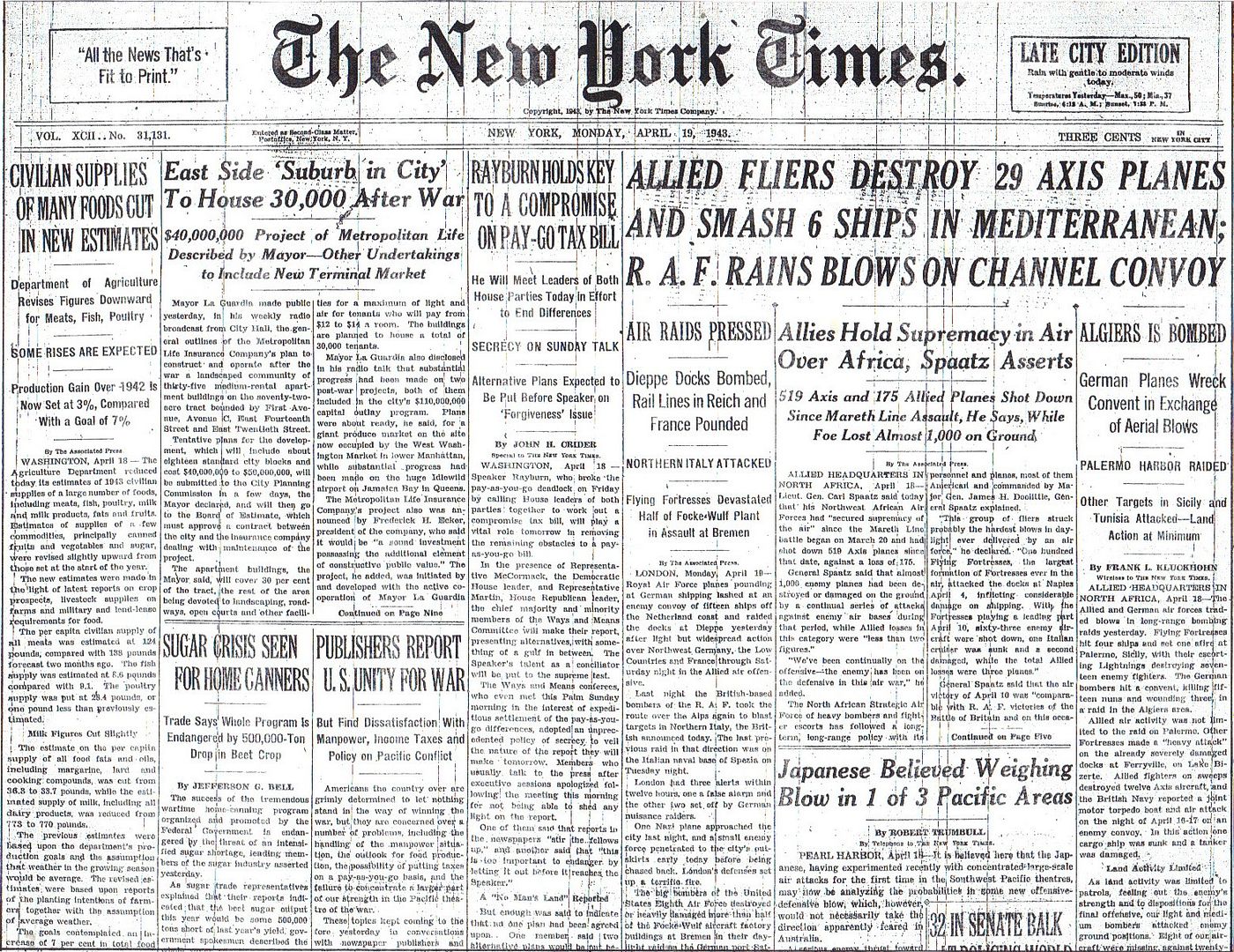
Posted on 04/19/2013 4:09:20 AM PDT by Homer_J_Simpson

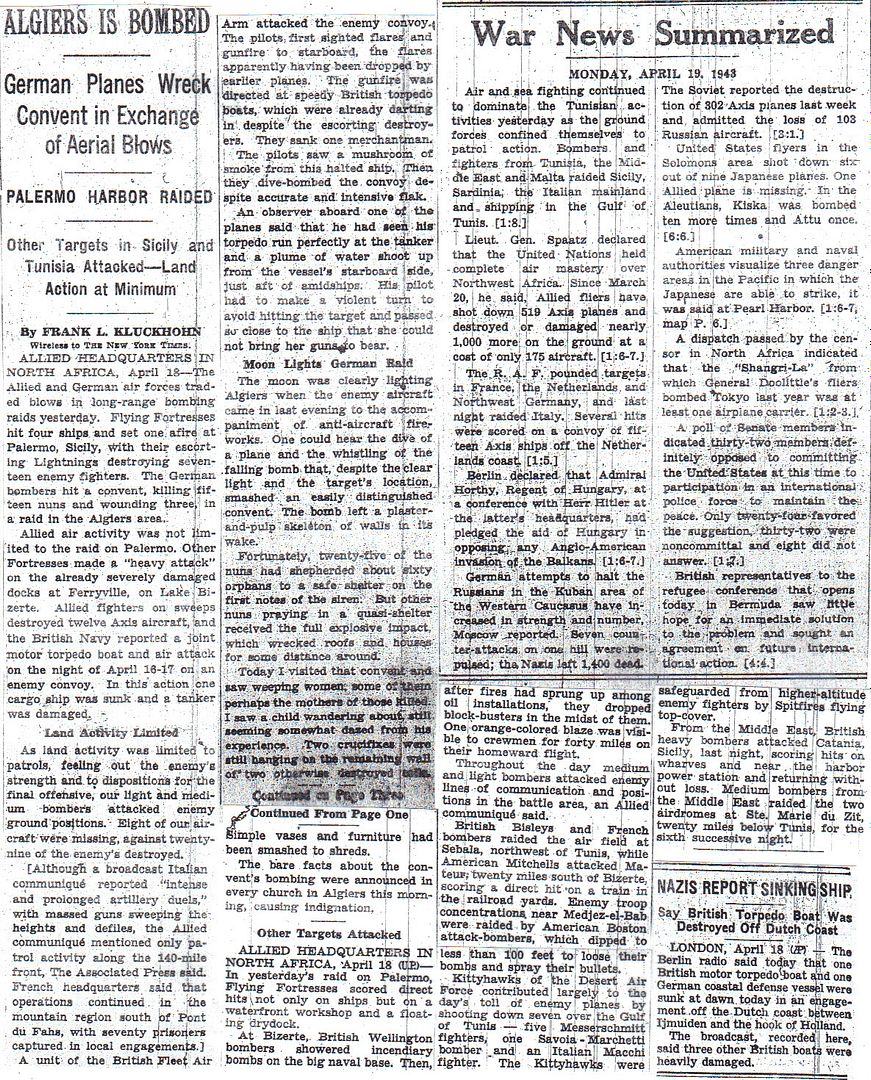
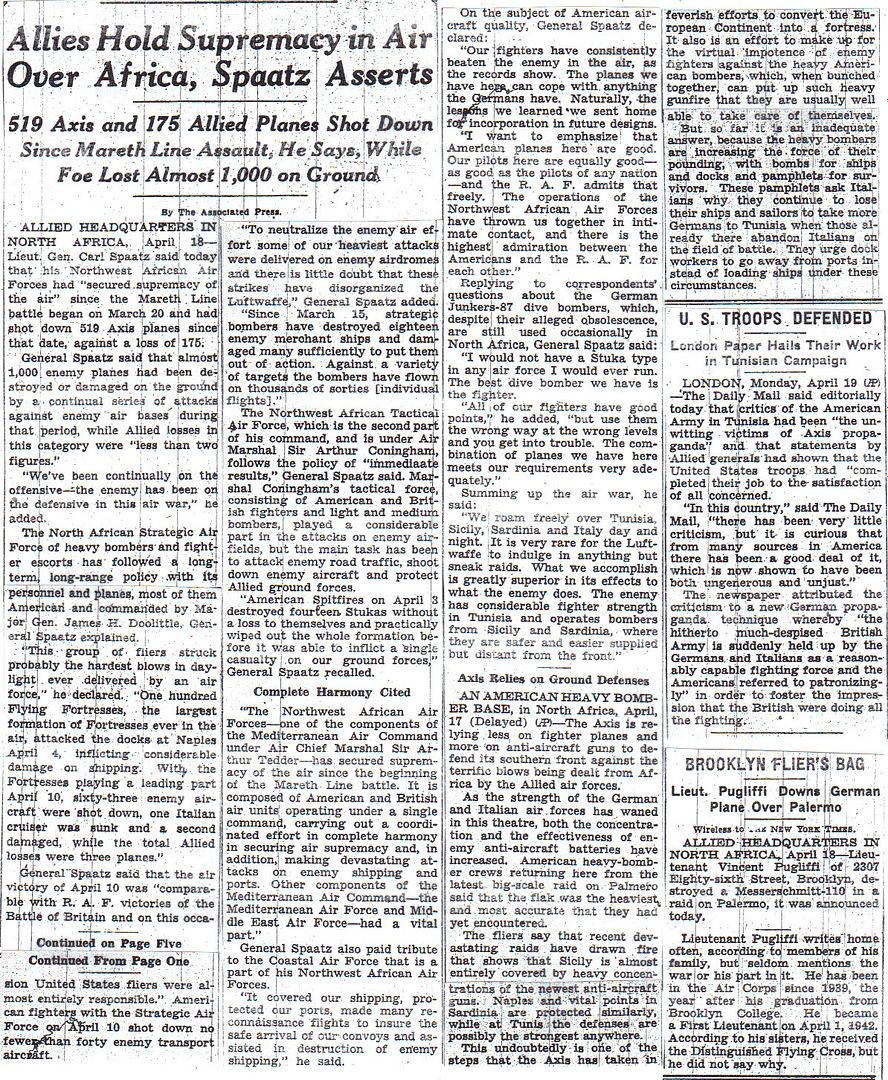

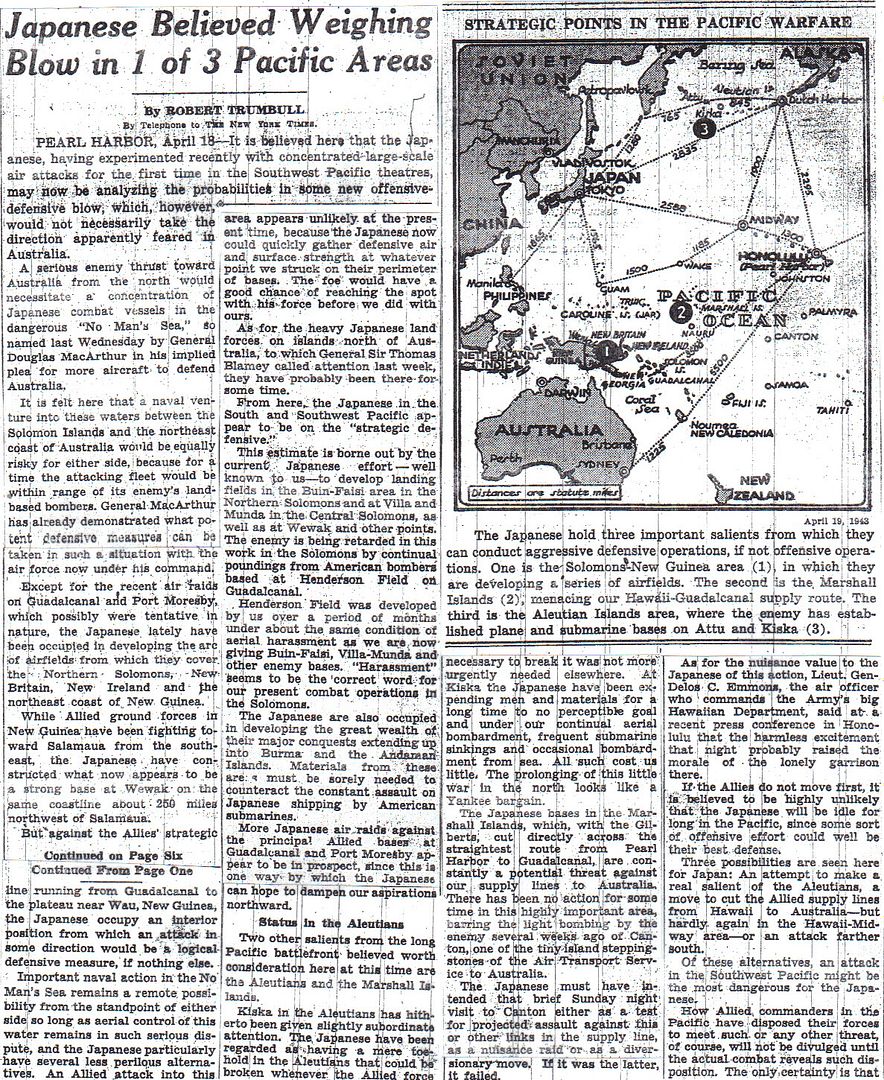

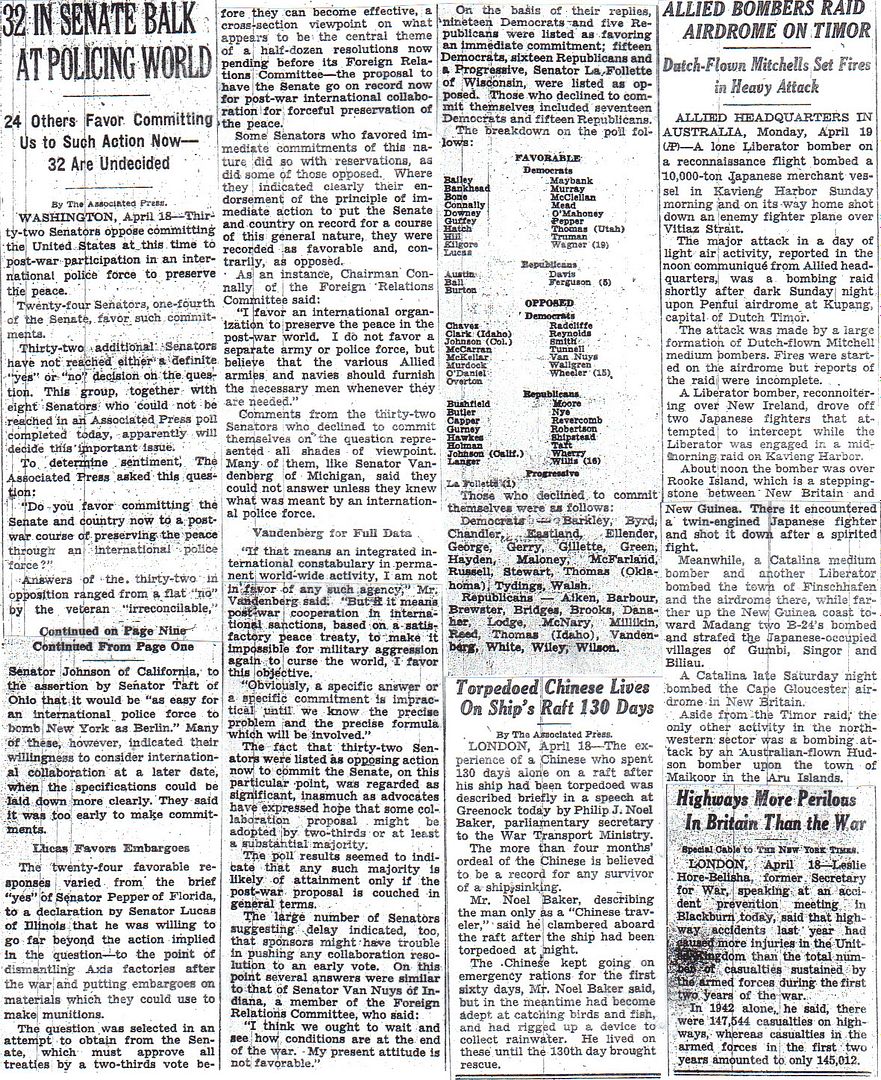

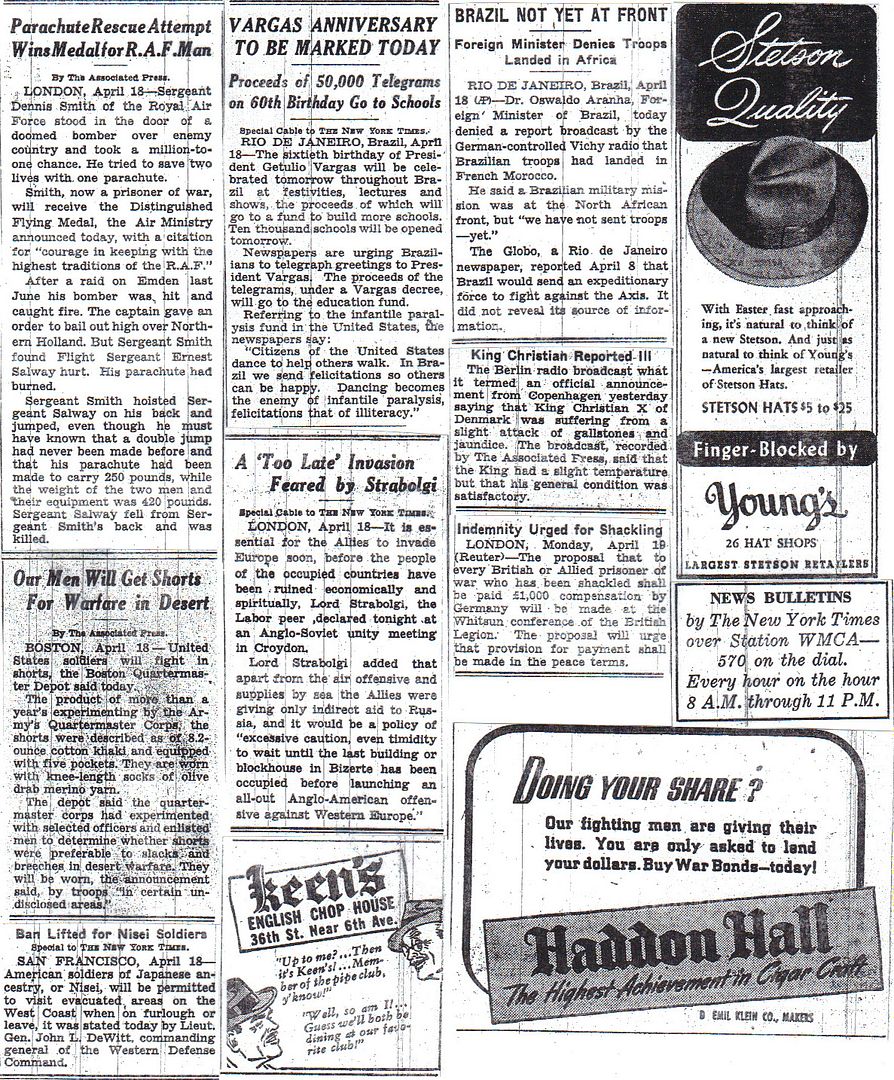
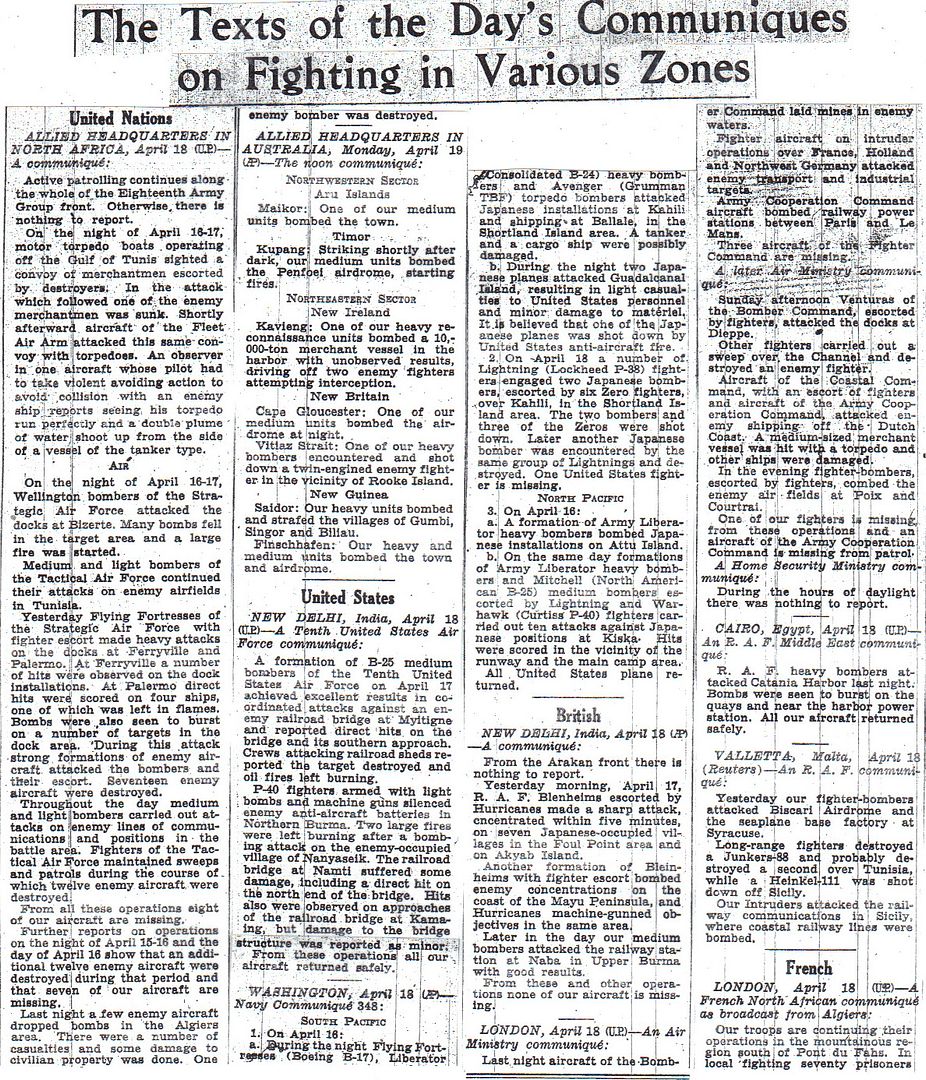
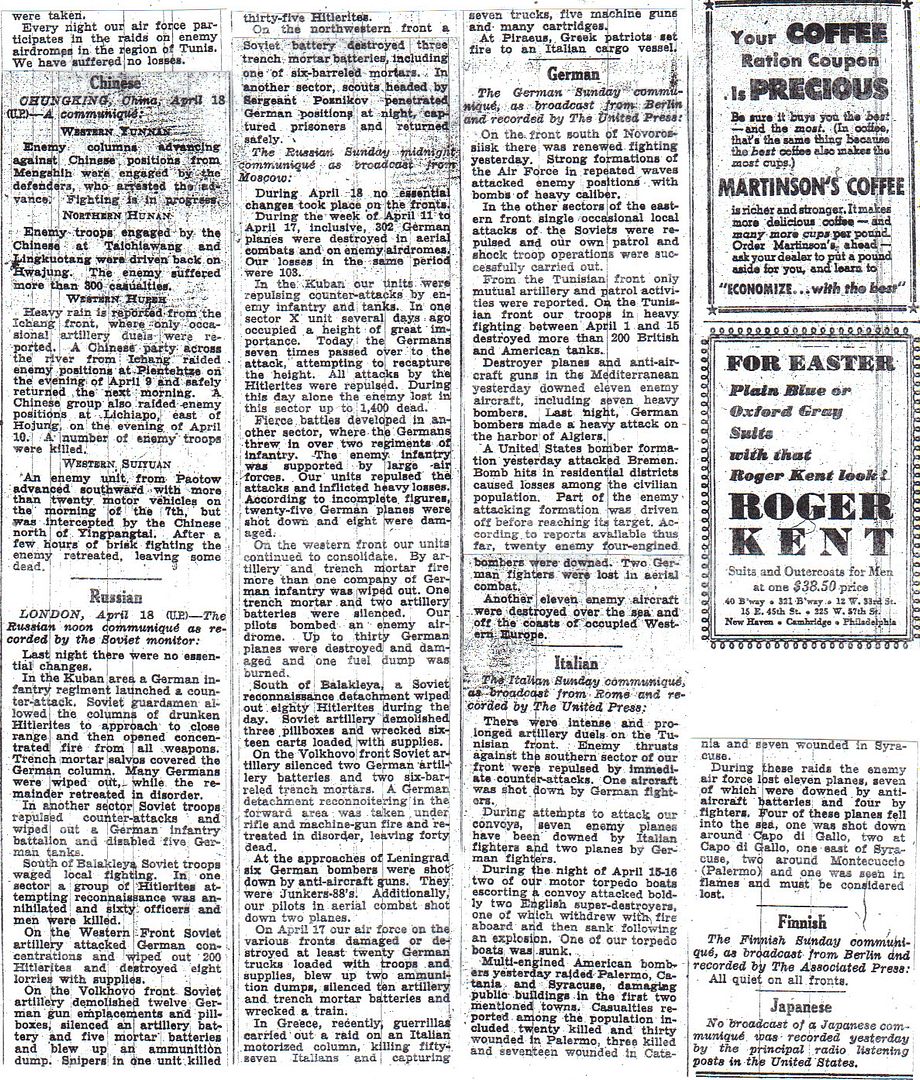
I understand you have discontinued the small sugar ration which was allowed to bees, and which in the spring months is most important to their work throughout the whole year.
Pray let me know what was the amount previously allotted. What is the amount of sugar still issued to professional bee-keepers, and what is the saving in starving the bees of private owners?
Winston S. Churchill, The Hinge of Fate
http://www.onwar.com/chrono/1943/apr1943/f19apr43.htm
Jews in Warsaw ghetto rise up
Monday, April 19, 1943 www.onwar.com
Nazis round up Jews in Warsaw ghetto [photo at link].
In Occupied Poland... The remaining population of the Warsaw ghetto rises against the Germans.
In Tunisia... Another effort to supply the Axis forces by air suffers heavy losses.
http://homepage.ntlworld.com/andrew.etherington/frame.htm
April 19th, 1943 (MONDAY)
BELGIUM: Resistance fighters stop a train of Jewish prisoners bound for Auschwitz.
Raf Casert , The Associated Press
Published: Thursday, April 19, 2007
BOORTMEERBEEK, Belgium — In the dark amid the steam engine’s hisses, Simon Gronowski snuggled against his mother on the straw of a cattle train packed with Jews bound for Auschwitz. Suddenly there were shrieks of brakes, shouts in German, and the rattle of gunfire.
Outside, Robert Maistriau’s fake stoplight had done its work and the Belgian resistance fighter forced open a car — letting 17 people out before he came under fire and was forced to flee with two accomplices.
It was April 19, 1943, the only documented case of resistance fighters stopping a train to free Jews.
Transport XX, with 1,619 remaining prisoners, started once again cutting its way through the night toward its secret destination. Simon, then 11, soon slumbered in his mother’s warm embrace, unaware of what the raid had started:
Prisoners emboldened by the rescue attempt started prying open the doors.
“When my mother woke me,” Gronowski recalled, “the door was wide open.”
Within seconds, his life changed. His mother Chana took him by the hand and lowered him onto the step, the rush of wind roaring in his face. She held his collar tight and he heard her shout in Yiddish: “Der tsug geyt tsu schnell!”
— the train goes too fast!
Simon had practiced jumping for freedom from the top beds of the Mechelen Dossin Barracks, 20 miles outside Brussels, ever since the Gestapo had locked up his family a month earlier. And when the train lost speed, he took the leap of his life — a 100 franc bill from his mother tucked tightly in his sock.
“Then I waited for my mother,” he said.
She never came. Nazi guards on the train realized there was another break and started shooting. Simon went on a mad, night-long rush through woods and fields along with about 200 others who had jumped from the cars.
His mother was gassed a few days later at Auschwitz. `Der tsug geyt tsu schnell,’ were the last words he’d hear her say.
Gronowski, now 75 and a lawyer for most of his life, recalled that April evening sitting on a velvet couch in an apartment in Brussels — side-by-side with the man he credits with saving his life, Maistriau.
“It is because of him that I am a father and a grandfather,” said Gronowski. “Of all the convoys, which traversed Europe between 1940 and 1945, hundreds of convoys of Jews, only one was stopped, my convoy, the 20th convoy. It is a unique fact, extraordinary.”
Ward Adriaens, director of the Jewish Museum of Deportation and Resistance near Brussels, said the rescue was unique in the history of the Holocaust.
“As far as we can see, in the whole of Europe where thousands and thousands of trains brought millions of people to the gas chambers, it is the only registered case of stopping a train to save Jews,” he said.
But Maistriau, the last survivor of the resistance team, brushed off accolades with a wan smile. “The Jews were the victims of war,” he said.
He did take pleasure in recalling how adrenaline coursed through his body as he flung open the door to the train car. To his horror, many prisoners refused to flee.
“I shouted in bad German that they had to leave, this was the moment to rescue themselves,” he said. “Some said ... `We’re going off to become farmers.’
I told them of the great dangers they faced.”
Then one prisoner seized the opportunity, and then a few more before the Germans started shooting and the train was again hurtling through the night.
Of the 232 who jumped, 26 were shot and killed. Eighty-seven were recaptured.
Maistriau gave money to a few who escaped, got on his bike and cycled away.
The next morning, he celebrated in a patisserie with one of his accomplices, Youra Livschitz, who was later executed as a resistance fighter. “After something like this, they go have pastries,” chuckled Gronowski.
On Friday, the Jewish Museum of Deportation and Resistance commemorates the raid and the victims with a project called “Give them a face.” Outside the Dossin barracks in Mechelen, billboards with some 1,200 passport pictures of the prisoners give the statistics human faces.
Gronowski was given a preview of the grainy photos. He scratched his white beard as he surveyed one old picture after another, mumbling “I am looking for my mother.”
After a walk along the billboards on the site where the train embarked for Auschwitz, he suddenly said: “Look, my mother.”
“I have never seen this photo,” he said. “She is very young in this photo.
I find her very beautiful.”
Up to the Allied victory in May 1945, Gronowski believed his mother and older sister Ita, who was on another train, would come back to him.
He was briefly reunited with his father, who was ill in a hospital when the family was rounded up and escaped capture. The father died shortly after liberation, broken by the deaths of his wife and daughter. “I was quite alone,”
Gronowski recalled.
For half a century, Gronowski never discussed the rescue for fear of plunging into depression. He broke his silence when he realized that as one of the last surviving witnesses he had a role to play in history.
“I want to fight anti-Semitism and revisionism,” he said. “I never get depressed anymore.”
By speaking out, Gronowski met Maistriau. As they chatted in the former resistance fighter’s apartment, they found they both have children working as lawyers in Brussels.
“Who could have thought that then?” Gronowski said.
But the memory of his mother haunts him.
“She knew she could not jump and run like a kid,” he said. “She sacrificed herself for me.”
(http://www.canada.com/ottawacitizen/story.html?id=34f1d219-af20-49a0-847d-bcaf603d5853&k=27732)
POLAND: The Warsaw Ghetto uprising begins. The Jews rise up and drive 2,000 heavily-armed SS troops under Lt-Gen Stroop from the ghetto.
The final liquidation of the Warsaw Ghetto is timed for the Eve of Passover, tonight.
The final liquidation of the Warsaw Ghetto began on the Eve of Passover, April 19, 1943. The deportation did not come as a surprise. The Germans had amassed a military force to carry it out, but did not expect to engage in a confrontation that included street battles. Armed German forces ringed the ghetto at 3:00 a.m. The unit that entered the ghetto encountered armed resistance and retreated. The main ghetto, with its population of 30,000 Jews, was deserted. The Jews could not be rounded up for the transport; the railroad cars at the deportation point remained empty.
After Germans and rebels fought in the streets for three days, the Germans began to torch the ghetto, street by street, building by building. The entire ghetto became a sizzling, smoke-swathed conflagration. Most of the Jews who emerged from their hideouts, including entire families, were murdered by the Germans on the spot. The ghetto Jews gradually lost the strength to resist. On April 23, Mordecai Anielewicz the ZOB commander wrote the following to Yitzhak Zuckerman, a member of the ZOB command who was stationed on the “Aryan” side: “I cannot describe the conditions in which the Jews are living. Only a special few will hold out; all the others will perish sooner or later. Their fate is sealed. None of the bunkers where our comrades are hiding has enough air to light a candle at night.... Be well, my dear, perhaps we shall yet meet. The dream of my life has risen to become fact.
Self-defence in the ghetto will have been a reality. I have been a witness to the magnificent, heroic fighting of Jewish men of battle”. The rebels pursued their cause, even though they knew from the outset that they could not win. Even before the war ended, the Warsaw Ghetto Uprising became a symbol of Jewish resistance. (Russ Folsom)
NORTH AFRICA: Another German effort to fly supplies into Tunisia fails.
TUNISIA: The British 8th Army makes small gains but suffers heavy casualties near Enfidaville, 45 miles (72 km) south of Tunis.
The U. S. II Corps takes over the northern end of the Allied line and prepares to attack.
Ninth Air Force B-25s hit landing grounds and defensive positions, and P-40s escort bombers and fly fighter sweeps in support of the British Eighth Army assault on Enfidaville.
During the night of 18/19 April, Northwest African Air Force Blenheims bomb La Marsa landing ground and roads nearby, and attack activity on beach at Reyville. During the day, B-17s bomb shipping at Tunis. B-25s and A-20 Havocs raid the La Sebala Airfield and fighter-bombers attack tanks in the battle area. (Jack McKillop)
BURMA: Tenth Air Force P-40s hit bridges, seriously damaging the Namti railroad bridge between Mogaung and Myitkyina. Nine B-24s bomb Rangoon’s main railroad station. (Jack McKillop)
NEW GUINEA: Fifth Air Force B-17s, B-24s and B-25s bomb airfields at Hollandia and Lae.
BISMARCK ARCHIPELAGO: Fifth Air Force B-17 Flying Fortresses, B-24s and B-25s mount individual attacks against Gasmata and Cape Gloucester Airfields on New Britain Island. (Jack McKillop)
SOLOMON ISLANDS: In the first night fighter victory in the Pacific, a USAAF P-70 shoots down a Mitsubishi G4M Navy Type 1 Attack Bomber (Allied Code Name “Betty”) near Tulagi Island at 0425 hours. (Jack McKillop)
PACIFIC OCEAN: The submarine USS Scorpion (SS-278) mines waters off Kashima Nada, Japan while USS Seawolf (SS-197) sinks a Japanese depot ship east of Okinawa. (Jack McKillop)
TERRITORY OF ALASKA: ALEUTIAN ISLANDS: The Eleventh Air Force flies 9 missions involving 14 B-24 Liberators, 12 B-25 Mitchells, 32 P-40s, and 23 P-38 Lightnings to Kiska Island. The first mission is weathered out of the primary target, Attu Island, and directed to Kiska. Bombing and strafing concentrates on 4 grounded ships and the submarine base area where fires are started. One ship, believed to serve as a power station, is set afire. (Jack McKillop)
"Irena Kleppfisch, a child survivor of the Holocaust, is an important writer whose best known works include a poem called 'Bashert.'
Its title, a Yiddish word, evokes senses of inevitability and fate.
As it grieves and protests, 'Bashert' does not mention the Holocaust directly, but that event shadows every line: 'These words are dedicated to those who died....These words are dedicated to those who survived.'
"Kleppfisch's father, Michael, was one of those who died. Israel Gutman, survivor and historian of the Warsaw Ghetto uprising, says that Michael Kleppfisch, 'who played an important role in the manufacture of armaments in the ghetto,' was killed on April 20, 1943.
He died in hand-to-hand fighting against Brigadier General Jürgen Stroop's German forces, who had been directed to liquidate the ghetto.
"In the summer of 1942, the Nazis removed 300,000 Jews from the Warsaw Ghetto. Most were sent to their deaths in Treblinka's gas chambers.
Michael Kleppfisch and Gutman were members of a group of young Jewish men and women--they numbered 700 to 750--who trained and armed themselves as best as they could.
They were determined to resist Nazi efforts to destroy the nearly 60,000 Jews who remained in the ghetto in the early spring of 1943.
"In January of that year, SS chief Heinrich Himmler had ordered further deportations, but Jewish resistance impeded that effort. Aware that they would meet determined resistance, the Germans regrouped and returned on Monday, April 19, the eve of Passover, to finish the job.
What ensued was, in Gutman's words, 'the first urban uprising in German-occupied Europe, and, among the Jewish uprisings, the one that lasted the longest, from April 19 to May 16, 1943.'
"The poorly armed Jewish fighters, who also lacked military training and battle experience, were outnumbered three-to-one by Nazi forces, who had tanks and cannons.
The Jews' "arsenal" consisted mainly of pistols, Molotov cocktails, and a few rifles, which had been smuggled into the ghetto or looted from Germans who were ambushed in January's resistance.
Using hit-and-run tactics and taking advantage of bunker hiding places, the Jewish fighters kept the Nazis off balance during the uprising's early days.
However, the Germans retaliated by burning the ghetto, building by building.
Even then, Jewish resistance continued--doomed though it was.
Not until May 8 did the Germans destroy the Jewish Fighting Organization's headquarters bunker at 18 Mila Street, a struggle in which Mordecai Anielewicz, the organization's commander, perished.
"On May 16 Stroop declared victory, proclaiming that 'the Jewish quarter of Warsaw no longer exists.'
The losses the Jewish fighters had inflicted on the Germans were militarily small--Stroop's report noted 16 dead and 85 wounded--but the Warsaw Ghetto uprising remains an immensely important example of heroic Jewish resistance against overwhelming odds."
Somehow I doubt if those numbers will hold true for every year of WWII.
For the Brits the first two years of the war was 9/1/39 through 8/31/41. The war in the Pacific hadn't even started yet. I would guess that casualties overtook auto accidents by year 3.
Disclaimer: Opinions posted on Free Republic are those of the individual posters and do not necessarily represent the opinion of Free Republic or its management. All materials posted herein are protected by copyright law and the exemption for fair use of copyrighted works.